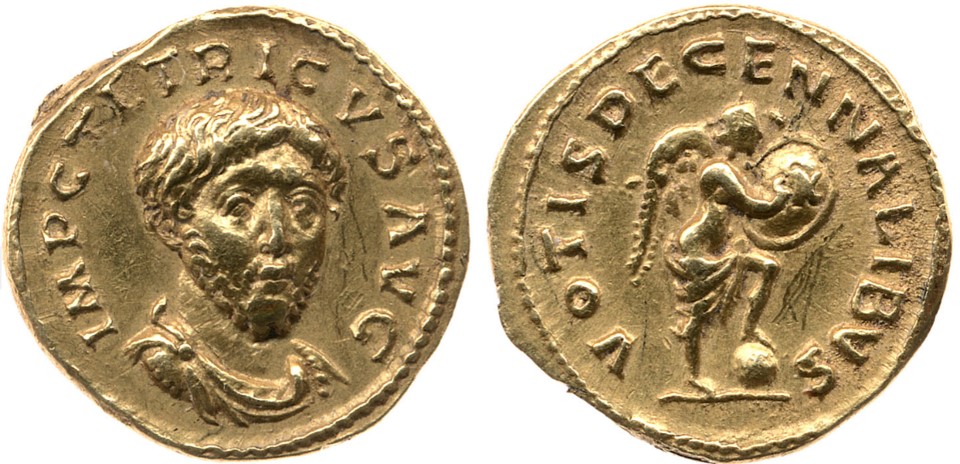Cologne (Tetricus I), gold, quinarii (271-274 CE)
From SILVER
271 CE - 274 CE Gold 680 kg
Description
| ObverseInscription or printing placed on the obverse.: | IMP C TETRICVS AVG (Latin).Bust of Tetricus I, draped, head, bare, three-quarters facing |
| ReverseInscription or printing placed on the reverse.: | VOTIS DECENNALIBVS (Latin).Victory, winged, naked to waist, standing right, left foot raised on globe, holding stylus in right hand inscribing oval shield with an X, which she balances with left hand on left knee |
Mint and issuing power
| MintIdentifies the place of manufacture or issue of a numismatic object.: | Cologne | Ancient regionAncient region.: | Gallia | Modern countryModern country: | AuthorityIdentifies the issuing power. The authority can be "pretended" when the name or the portrait of X is on the coin but he/she was not the issuing power. It can also be "uncertain" when there is no mention of X on the coin but he/she was the issuing power according to the historical sources: | Roman Empire, Tetricus I (271-274 CE) |
Chronology
| FromIdentifies the initial date in a range assigned in a numismatic context. | 271 CE | toIdentifies the final date in a range assigned in a numismatic context.. | 274 CE | PeriodTime period of the numismatic object.: Roman from 30 BC |
Physical description
| MetalThe physical material (usually metal) from which an object is made.: | Gold |
Median weightMedian of the weights of numismatic objects (in grams). in grams | 2.10 | DenominationTerm indicating the value of a numismatic object. Examples: tetradrachm, chalkous, denarius.: | quinarius | StandardStandard.: |
Image

Tetricus quinarius.jpg [1]
References
| Die study referencePublication of the study: | Schulte 19831Schulte 1983, p. 167 | ||
| Coin series referenceReference to coin series study: | RIC 52RIC 5, p. 405, n° 2 | ||
Obverse dies distribution
| FrequencyFrequency of specimen in distribution. ᵖ | Number of obversesNumber of obverse dies. ᵖ (o) | % (o) | Number of coinsNumber of coins. (n) | % (n) | Die nameName(s) of the die(s). |
| 2 | 1 | 100 | 2 | 100 | 1 |
| Total | 1 of 1 | 100 | 2 of 2 | 100 |
Reverse dies distribution
no distribution is available
Quantification
| Number of obversesNumber of obverse dies. ᵖ (o) | 1 | Number of singletons (o1)The number of singleton coins. ᵖ | 0 |
| Number of reverse diesNumber of reverse dies. (r) | 1 | Number of coinsNumber of coins. (n) | 2 |
| Coins per obverse dieNumber of coins per obverse die. (n/o) | 2 | Coins per reverse dieNumber of coins per reverse die. (n/r) | 2 |
| Reverse per obverse ratioRatio of obverse dies divided by reverse dies. (r/o) | 1 | Percentage of singletons (o1)number of coins (n) divided by the number of singletons (o1) ᵖ | 0 % |
| Original number of dies (O) (Carter 1983 formula)The estimation of the number of coins according to Carter 1983 ᵖ | 1.62 | Coins struck if 20,000 as average productivity per dieCoins made if the average productivity for obverses (according to Carter) is 20,000. ᵖ | 32,400 |
| Original number of dies (O) (Esty 2011 formula)The estimation of the number of coins according to the singleton formula in Esty 2011 ᵖ (O) | 2 | Survival rate if 20,000 as average productivity per dieSurvival rate if average productivity is 20,000. ᵖ | 0.00006 |
| Coverage (o = % of O) (Esty 1984 formula)Esty 1984 - coverage (% of O) ᵖ (o = % of O) | 100% | Die productivity if survival rate 1/2,000Average productivity if survival rate is 1/2,000. ᵖ | 2,469.14 |
| Weight of silver (in kg) if 20,000 coins per die (O = Carter formula)Carter 1983 * Median weight * 20000 (*10 if gold or electrum) ᵖ | 680 kg <br /> 680 kg | Die productivity if survival rate 1/5,000Average productivity if survival rate is 1/5,000. ᵖ | 6,172.84 |
Remarks
Most likely one single workstation Certainly military